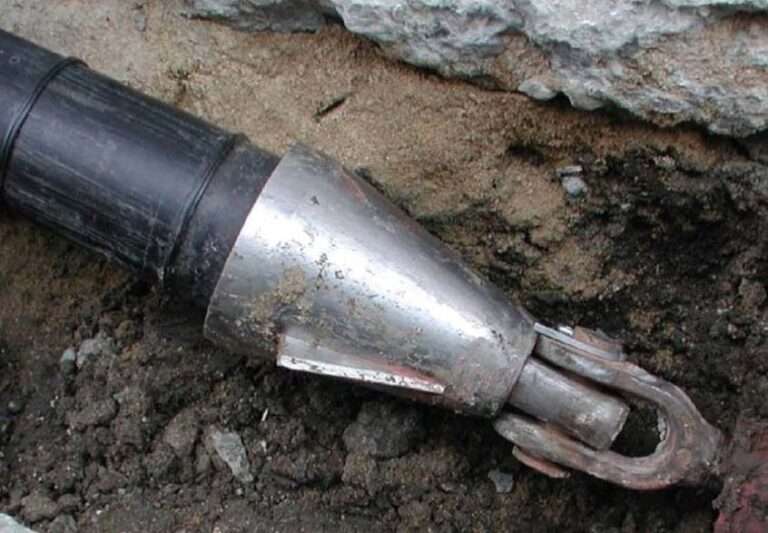Traditionally, replacing underground pipes for water, sewer, or natural gas involved the labor-intensive process
of digging a construction trench. However, advancements in plumbing and construction techniques have led to the development of pipe bursting. This method offers an alternative to conventional trenching, reducing both the financial burden and environmental impact typically associated with traditional pipe replacement methods.
Explaining the Pipe Bursting Process
Pipe bursting revolutionizes traditional pipe replacement, which typically involves extensive trench digging to access and replace old pipes. Traditionally, after removing the old pipes, new ones are installed, and then the trenches are refilled. This process can span days or even months, varying with the project’s scale.
With pipe bursting, the necessity for extensive trench excavation is eliminated. Workers create a series of smaller launching and receiving pits. Through these pits, the new pipe is introduced. A specialized pipe bursting tool is used to fragment the old pipe while simultaneously laying the new pipe in its place. This tool is then retrieved from the receiving pit and reused for subsequent sections. This method significantly reduces surface disruption and is generally more time-efficient than traditional methods.
Overview of Different Pipe Bursting Techniques and Their Applications
Pipe bursting, a method for replacing old pipes, comes in four distinct forms: lateral, pneumatic, hydraulic, and static bursting. Each type has its unique advantages and is suited for specific applications.
-
Lateral Bursting:
- Method: Utilizes a steel cone pushed through existing pipes to fragment them.
- Application: Ideal for smaller diameter pipes (under four inches) and those with multiple bends. Sometimes, a rotary device replaces the cone for enhanced efficiency.
-
Pneumatic Pipe Bursting:
- Method: Involves a pneumatic head with an expander, functioning like a jackhammer to break the old pipe.
- Application: Suitable for pipes between four and fifty-four inches in diameter. Commonly used for pressure and gravity pipes.
-
Hydraulic Bursting:
- Method: Employs hydraulic cylinders in the bursting head to expand and crack steel and iron pipes.
- Application: Frequently used for steel and iron pipes, like those in manholes.
-
Static Bursting:
- Method: Uses a high-tension drum or hydraulic jack winch.
- Application: Standard choice for replacing water and gas lines, particularly for iron or steel pipelines between four and forty-eight inches in diameter.
Each of these bursting methods offers a tailored approach to pipe replacement, ensuring minimal disruption and efficient installation for various pipe types and conditions.
The Advantages of Choosing Pipe Bursting
Pipe bursting offers a highly efficient and cost-effective alternative for accessing and replacing old or deteriorated pipes, eliminating the extensive time and labor involved in traditional trench digging. This method reduces the need for extensive excavation, thereby minimizing the damage to lawns, gardens, and surrounding landscapes, which can be costly for homeowners. For city repairs, the advantages extend further, as it lowers the expenses associated with repairing roadways, sidewalks, and other infrastructure elements affected by soil disruption and excavation.
Enhanced Efficiency and Time-Saving Benefits of Pipe Bursting
One of the significant advantages of pipe bursting is its efficiency in terms of both cost and time. Home projects employing this method typically conclude within a day, while larger commercial endeavors may require a bit more time.
The Rising Popularity of Pipe Bursting Technology
The growing preference for pipe bursting technology is partly attributed to its enhanced safety compared to traditional excavation methods. Frequently, hazardous materials like asbestos and mold are present in the soil. The minimal ground disturbance with pipe bursting means reduced exposure to these dangerous elements for workers, contributing to its increased adoption.
Enhancing Productivity in Underground Pipe Repair with Pipe Bursting
For businesses specializing in underground pipe repair, pipe bursting significantly boosts productivity. This method reduces time spent on excavation and cleanup, leading to more efficient and precise job completions. On average, companies can install about 200 meters of pipe daily using pipe bursting techniques.
Advantages of Pipe Bursting Over Traditional Methods
- Cost-Effectiveness: Pipe bursting is generally more affordable than traditional trenching methods, especially considering the reduced labor and time involved. Home projects often wrap up within a single day.
- Reduced Labor Intensity: Though some machinery is required for creating launch and receiving pits, it is considerably less than what is needed for extensive soil excavation in traditional methods.
- Minimal Landscape Disturbance: Traditional trenching can disrupt entire lawns and cause geological settling that may damage foundations. Pipe bursting, being a trenchless method, disturbs only a small area, significantly reducing the risk of soil settlement and related damage.
- Increased Flow Capacity: Pipe bursting not only allows for the replacement of existing pipes but also the installation of larger diameter pipes in the same space, leading to improved flow capacity in the new plumbing.
- Efficiency and Safety: This technology enhances job efficiency and accuracy. With minimal exposure to potentially harmful elements found in the soil, it also ensures greater safety and productivity for workers.
Pipe bursting stands out as a safer, more efficient alternative to traditional pipe repair methods, offering numerous benefits from cost savings to minimal environmental impact.

